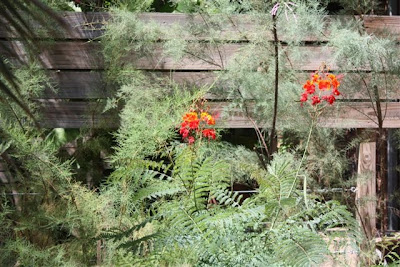Bird of Paradise Shrub - Caesalpinia
This beautiful Caesalpinia is the tropical variety, Caesalpinia pulcherrima, growing at the home of one of Russell Studebaker's friends in Tulsa.
In fact, Studebaker wrote about Caesalpinia in an August Tulsa World column.


Also called the Pride of Barbados, it is cold hardy to zone 8.
(Tulsa is zone 7, and northwest Arkansas is zone 6, so if we want to grow it, we have to protect it in the winter.)
Another variety, Caesalpinia gilliesii is native to Oklahoma, Texas, Arizona, etc. It's flowers are not as red but are equally beautiful and dramatic.
Even though it is said to be cold hardy only to zone 8, the USDA site shows its native territory including OK.
Sharon Owen's parents grew it beside their house in a protected spot in Muskogee so I remain hopeful that when my seed-started plant is two years old (next year) it can safely be planted in the ground. Sharon (Moonshadow Herb Farm) bought a few seeds and shared them with me.
UCB featured it last year.
The Univ of Arizona Master Gardeners featured the plant on their site.
Photo of Caesalpinia gilliesii
Arizona Master Gardener's website
One Arizona nursery, Horticulture Unlimited, features Yellow Bird of Paradise, C. gilliesii.
You can see by the leaf form that it's in the pea or legume family. Mary Ann King,owner of Pine Ridge Gardens said that cold, wet planting soil will rot the seeds.
So if you decide to go with seeds, plant them in a loose mix, keep them well drained and warm.
Start the seeds now while the weather is still warm.
Seeds for the tropical C. pulcherrima Thompson Morgan
Seeds for the locally hardy C. gilliesii Chiltern and Tradewinds Fruit
C. gilliesii plants will be available from Bustani Plant Farm next spring.
My seed-grown plant is only 1.5 years old. It's still in a one gallon pot and I'll bring it inside one more winter before having the courage to put it out into the harsh conditions we have here.



Comments